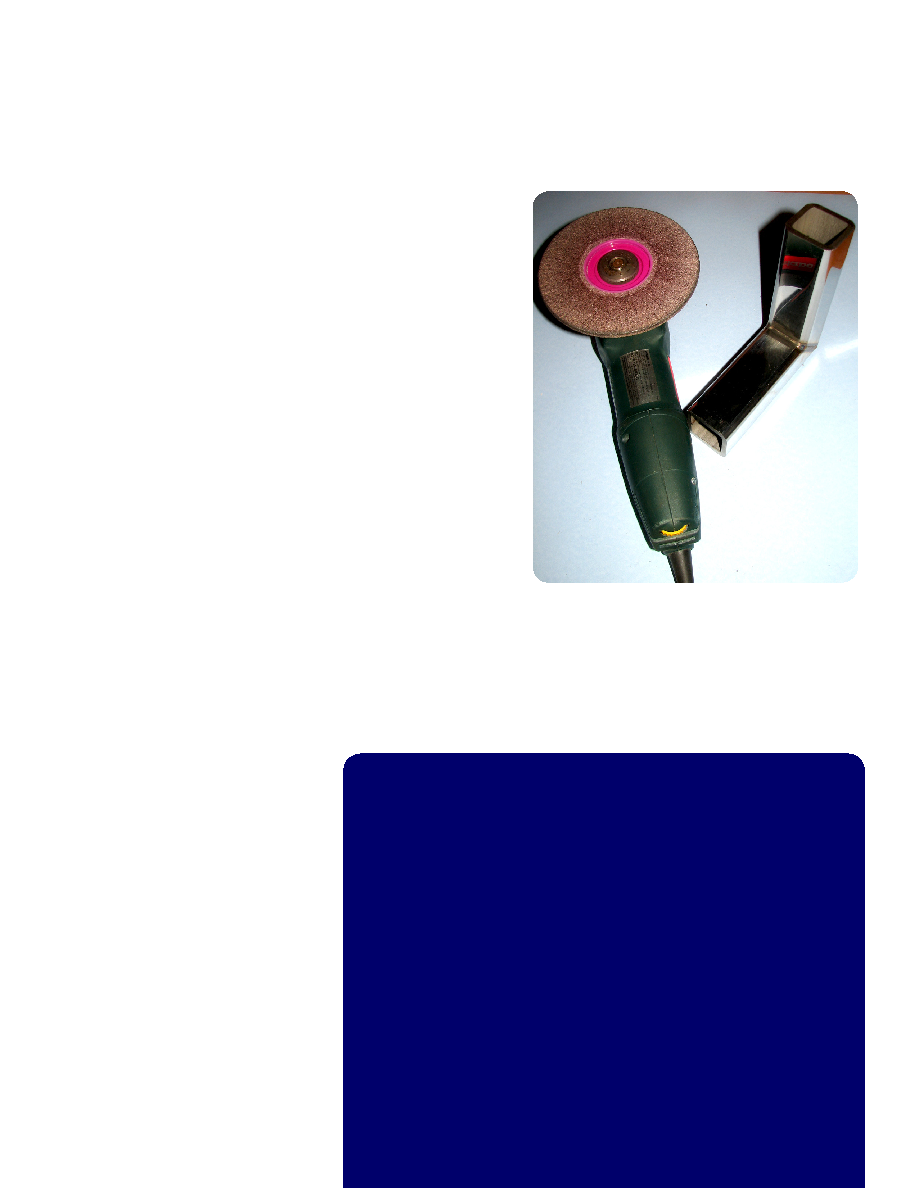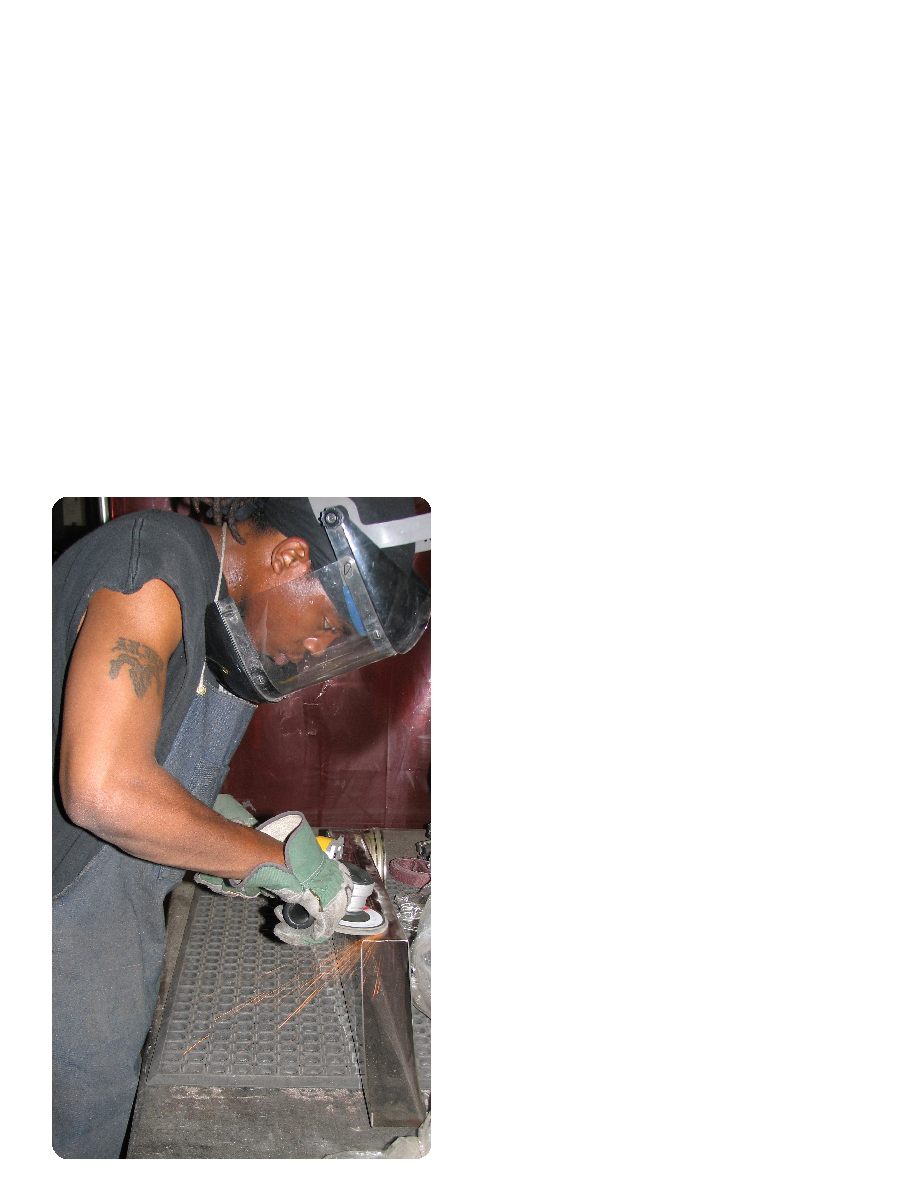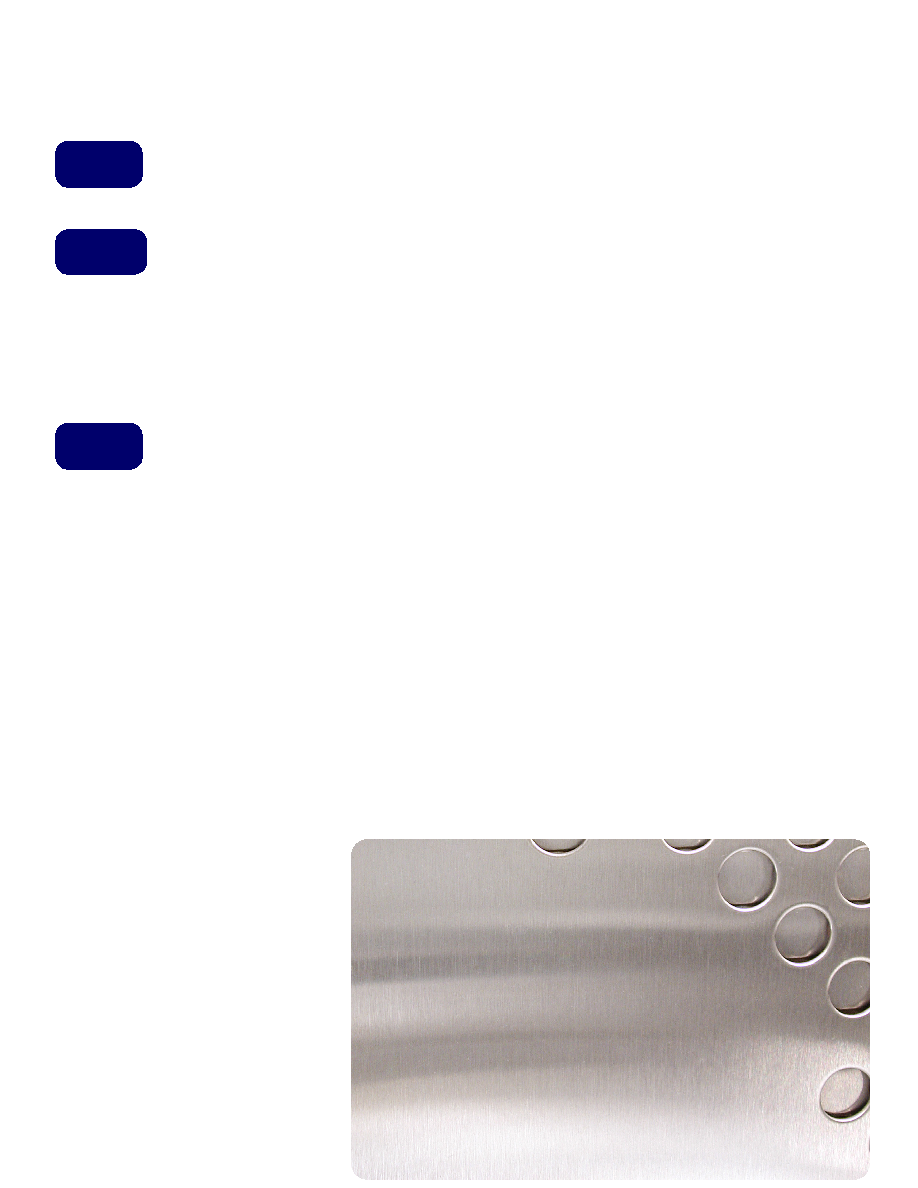
Over the last several years,
there has
been an explosion of new abrasives and
more powerful right angle grinders on
the market.Many of these products are
providing impressive results in cutting,
grinding and finishing tasks for many
industries, including metalworking. Ad-
ditionally, these products, when chosen
correctly for the task at hand, can reduce
both costs and finishing time.
User-friendly improvements to
the right angle grinder
The right angle grinder is generally the
most widely used tool in any metalwork-
ing shop. New developments in
the grinder itself include more powerful
variable speed motors, improved ergo-
nomics, and vibration dampening de-
signs.
The newer grinders, when used to per-
form different tasks, allow the user to ad-
just the speed. This becomes especially
critical when changing from grinding to
polishing. Polishing at slower speeds al-
lows the operator better control over the
work piece and improves the aesthetics of
the final surface finish. In addition, stud-
ies have shown that altering the speed
of the grinder to the optimum level can
double the working life of the abrasive in
use.
For individuals who use
the grinder for a significant
amount of time each day,
new ergonomic vibration
dampening designs from
companies such as Metabo,
Fein, and Makita reduce
repetitive use injuries and
worker downtime. This is
because the vibration from the grinder is absorbed by the handle and not transferred
to the workers themselves. Also, the newer designs make the grinder lighter, thereby
reducing operator fatigue, and allow for optimum hand position while grinding.
The Latest Abrasives
BY CHRIS STONE
In the metal finishing arena, the right-angle
grinder is "king" of the hand-held power
tools.
For Your Information
Some factors that affect how quickly a substance is abraded in-
clude:
Difference in hardness between the two substances: a much
harder abrasive will cut faster and deeper. Grain size (grit
size): larger grains will cut faster as they also cut deeper.
Adhesion between grains, between grains and backing, be-
tween grains and matrix: determines how quickly grains are
lost from the abrasive and how soon fresh grains, if present,
are exposed.
Contact force: more force will cause faster abrasion. Loading:
worn abrasive and cast off work material tends to fill spaces
between abrasive grains so reducing cutting efficiency while
increasing friction.
Use of lubricant/coolant/metalworking fluid.
Source: Wikipedia
·
·
·
·

Flap dISCS
For material removal, including weld
grinding, blending, and deburring, again
the angle grinder is still the workhorse of
most metalworking shops.
In most material removal operations, the
old two-step process of grinding wheel
and then fiber disc finishing has been re-
placed with the advent of the flap discs.
Flap discs grind and finish in one step,
thereby reducing both finishing time and
finishing costs. In addition, by using a
variable speed grinder and flap disc, the
user can further extend by 50 percent the
working life of the flap disc by keeping
the rpm between 5000 and 8000.
Advantages of the flap disc include:
Grinds and finishes at the same time,
saving both time and money.
Removes material aggressively. Its
removal power is equal to that of the
depressed center wheel, but it works
more safely and offers a better-fin-
ished surface.
Has a lightweight design to reduce
operator fatigue.
Is easy to use and requires very little
surface pressure.
Its especially cool cutting permits
light contouring and avoids burning
the work piece by overheating.
Lasts up to 30 times longer than
conventional fiber discs due to their
overlapping flap construction.
Assures consistent performance as
new particles re continually exposed
during the life of the product.
Due to its tough construction, allows
for aggressive edge grinding.
The quality of flap discs varies greatly
from manufacturer to manufacturer.
When choosing a flap disc vendor, the
purchaser should look for two distinc-
tions: the type of coated abrasive; and the
manufacturer of the coated abrasive flaps,
which are glued to the backing of the flap
disc.
·
·
·
·
·
·
·
·
Requires less force for cutting
Reduces base material loss during
the cutting operation
Generates less heat
Improves surface finish on the cut
material
These higher quality wheels use a mix-
ture of aluminum oxide and zirconia
grains to improve cutting life, along with
reinforced layers of mesh, which provide
added strength to the disc.
When working with stainless steel or
other high nickel alloys, the user should
be sure that the cut off
wheel issulfur and chlo-
ride free, which will
prevent contamination
of the work piece. It is
important to choose a
wheel from a reputable
manufacturer and use
the proper guards and
flanges when cutting,
as an inferior wheel
can easily blow apart in
the thinner design and
present a hazard to the
operator. The new cut
off wheels can be found
in diameters ranging
from 3 to 7 inches and
thicknesses of .035 to
.045 inches.
·
·
·
·
CuT OFF wHEElS
When cutting with a right angle grind-
er, the latest advent of thinner slicing
cut off wheels allows faster cutting with
less material loss. The new, thinner de-
signed, type 1 wheels minimize the sur-
face area contact between the material
and the wheel due to the reduced sur-
face width of the wheel. The reduced
surface cutting area provides the follow-
ing benefits:
When choosing a flap disc vendor, the purchaser should
look for two distinctions: the type of coated abrasive; and
the manufacturer of the coated abrasive flaps, which are
glued to the backing of the flap disc.
Clean
and strip
discs
clean
metallic
surfaces
without
material
removal
(LEFT)
.

TYpE OF COaTEd aBRaSIvE
Characteristics of different types are appropriate
to different applications:
Aluminum oxide is suitable to
most general purpose applica-
tions and is specified for use on
wood and most metals.
Zirconia Alumina grains are
both sharp and durable, pro-
viding fast stock removal and
longer life. They are used to
greatest advantage in coarse
grits on heavy-duty metal-
working stock removal appli-
cations. Zirconia will generally
last twice as longs as Alumi-
num Oxide material.
Ceramic grain series are spe-
cial products for aggressive and
cool grinding. These abrasives
ensure faster grinding while at
the same instance offer better
surface quality and excellent
stock removal rates. The cool
grinding properties ensure an
extension of the service life
and prevent surface discolor-
ation. Ceramics are specifi-
cally applicable for grinding
high alloyed steels, titanium,
nickel alloys and all extremely
hard materials. Ceramics will
generally last 50 percent longer
than Zirconia material.
COaTEd aBRaSIvE FlapS
maNuFaCTuRERS
For all intents and purposes, there are no lon-
ger any U.S. companies manufacturing coated
abrasives. The best material is supplied by
leading European companies such as Nor-
ton (French), VSM (German), and
Klingspor (German). Caution is advised
when purchasing coated abrasives,as there
are inferior products being manufactured in
the Far East that might cost less, but will not
last very long when put into use.
Other factors that figure into the life of the
flap disc include the durabilityof the backing
(either fiberglass or nylon) and the number
of flaps laid on the disc. Higher quality discs
use extra layers of both fiberglass backing
and coated abrasives flaps.
good
About the Author:
Chris Stone is owner of lehigh valley abrasives,
supplier of abrasives and power tools for metal working.
lehigh valley abrasives originated in 1967 as a fabricator
of stainless steel tanks, vessels, and hoppers for the food,
pharmacuetical, and chemical industries. The demand
from customers for improved surface finishes led to the
company's development and manufacturing of flap discs,
belts, and cut-off wheels.
This article was printed in the September/October 2007
issue of Fabricator magazine.
For more information:
Finally, due to the prevalence of right angle grinders in the workplace, a
number of newer abrasive products tailored to cleaning and finishing have
been adapted for use on the grinder. They include:
-- These discs clean metallic surfaces without
material removal. They are a safer alternative to wire brushes. The primary
applications for clean and strip discs include:
Removal of paint and adhesives
Cleaning of weld seams
Removal of welding scale and discoloration
Surface preparation for auto body work
-- Surface
conditioning discs are composed of open nylon webbing, impregnated with
abrasive grains. They offer a continuous and controlled finish with minimal
material removal. Also, they are flexible in nature and allow polishing of con-
toured surfaces. Surface conditioning products are used heavily in the stain-
less steel fabrication industries for providing a satin finish to the
base material and welds. Additional applications include:
gasket removal
coatings removal
cleaning weld splatter
removing heat discoloration
Graining stainless steel sheet
Type 27 unitized wheels are an excellent choice for the final polishing step
on stainless welds as they blend tool marks, remove surface imperfections
and leave a bright clean finish on stainless steel, titanium, and aluminum.
The unitized wheel is composed of layers of non-woven material, impreg-
nated with abrasive grain and pressed together into its final shape. The unit-
ized wheel design allows for edge grinding and access to weld joints that
sometimes cannot be reached with a flap disc.
The advent of new abrasives and changes to the right angle grinder allow
the user to accomplish most finishing tasks with a single right angle grinder.
Newer abrasive materials last longer, provide an improved surface finish, and
get the job done faster and at a lower total cost. And finally, the newer angle
grinders are more powerful and safer due to improved ergonomics.
The latest developments and improvements allow the right angle grinder
to maintain its role as the king of the hand held power tool in the metal
finishing arena.
·
·
·
·
·
·
·
·
better
best


